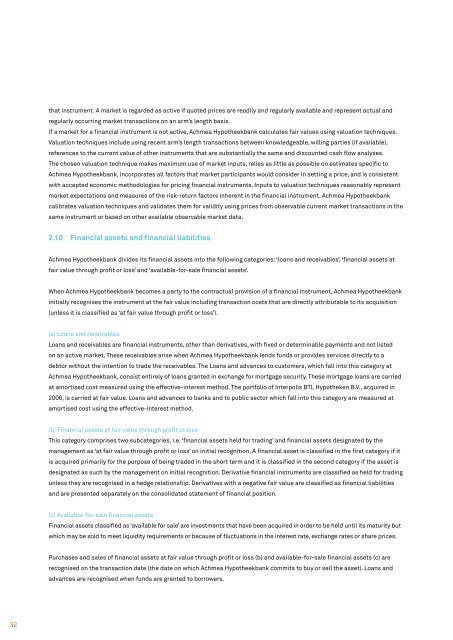Achmea Hypotheekbank N.V. annual report 2011
Achmea Hypotheekbank N.V. annual report 2011
Achmea Hypotheekbank N.V. annual report 2011
Create successful ePaper yourself
Turn your PDF publications into a flip-book with our unique Google optimized e-Paper software.
that instrument. A market is regarded as active if quoted prices are readily and regularly available and represent actual and<br />
regularly occurring market transactions on an arm’s length basis.<br />
If a market for a financial instrument is not active, <strong>Achmea</strong> <strong>Hypotheekbank</strong> calculates fair values using valuation techniques.<br />
Valuation techniques include using recent arm’s length transactions between knowledgeable, willing parties (if available),<br />
references to the current value of other instruments that are substantially the same and discounted cash flow analyses.<br />
The chosen valuation technique makes maximum use of market inputs, relies as little as possible on estimates specific to<br />
<strong>Achmea</strong> <strong>Hypotheekbank</strong>, incorporates all factors that market participants would consider in setting a price, and is consistent<br />
with accepted economic methodologies for pricing financial instruments. Inputs to valuation techniques reasonably represent<br />
market expectations and measures of the risk-return factors inherent in the financial instrument. <strong>Achmea</strong> <strong>Hypotheekbank</strong><br />
calibrates valuation techniques and validates them for validity using prices from observable current market transactions in the<br />
same instrument or based on other available observable market data.<br />
2.10 Financial assets and financial liabilities<br />
<strong>Achmea</strong> <strong>Hypotheekbank</strong> divides its financial assets into the following categories: ‘loans and receivables’, ‘financial assets at<br />
fair value through profit or loss’ and ‘available-for-sale financial assets’.<br />
When <strong>Achmea</strong> <strong>Hypotheekbank</strong> becomes a party to the contractual provision of a financial instrument, <strong>Achmea</strong> <strong>Hypotheekbank</strong><br />
initially recognises the instrument at the fair value including transaction costs that are directly attributable to its acquisition<br />
(unless it is classified as ‘at fair value through profit or loss’).<br />
(a) Loans and receivables<br />
Loans and receivables are financial instruments, other than derivatives, with fixed or determinable payments and not listed<br />
on an active market. These receivables arise when <strong>Achmea</strong> <strong>Hypotheekbank</strong> lends funds or provides services directly to a<br />
debtor without the intention to trade the receivables. The Loans and advances to customers, which fall into this category at<br />
<strong>Achmea</strong> <strong>Hypotheekbank</strong>, consist entirely of loans granted in exchange for mortgage security. These mortgage loans are carried<br />
at amortised cost measured using the effective-interest method. The portfolio of Interpolis BTL Hypotheken B.V., acquired in<br />
2006, is carried at fair value. Loans and advances to banks and to public sector which fall into this category are measured at<br />
amortised cost using the effective-interest method.<br />
(b) Financial assets at fair value through profit or loss<br />
This category comprises two subcategories, i.e. ‘financial assets held for trading’ and financial assets designated by the<br />
management as ‘at fair value through profit or loss’ on initial recognition. A financial asset is classified in the first category if it<br />
is acquired primarily for the purpose of being traded in the short term and it is classified in the second category if the asset is<br />
designated as such by the management on initial recognition. Derivative financial instruments are classified as held for trading<br />
unless they are recognised in a hedge relationship. Derivatives with a negative fair value are classified as financial liabilities<br />
and are presented separately on the consolidated statement of financial position.<br />
(c) Available-for-sale financial assets<br />
Financial assets classified as ‘available for sale’ are investments that have been acquired in order to be held until its maturity but<br />
which may be sold to meet liquidity requirements or because of fluctuations in the interest rate, exchange rates or share prices.<br />
Purchases and sales of financial assets at fair value through profit or loss (b) and available-for-sale financial assets (c) are<br />
recognised on the transaction date (the date on which <strong>Achmea</strong> <strong>Hypotheekbank</strong> commits to buy or sell the asset). Loans and<br />
advances are recognised when funds are granted to borrowers.<br />
32
















